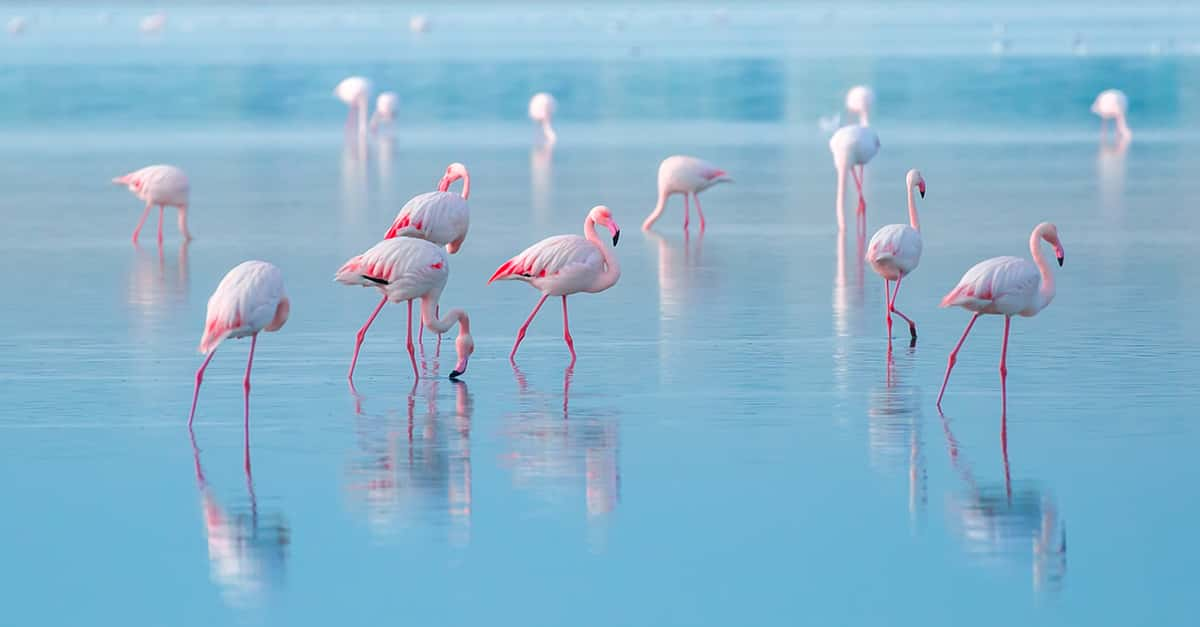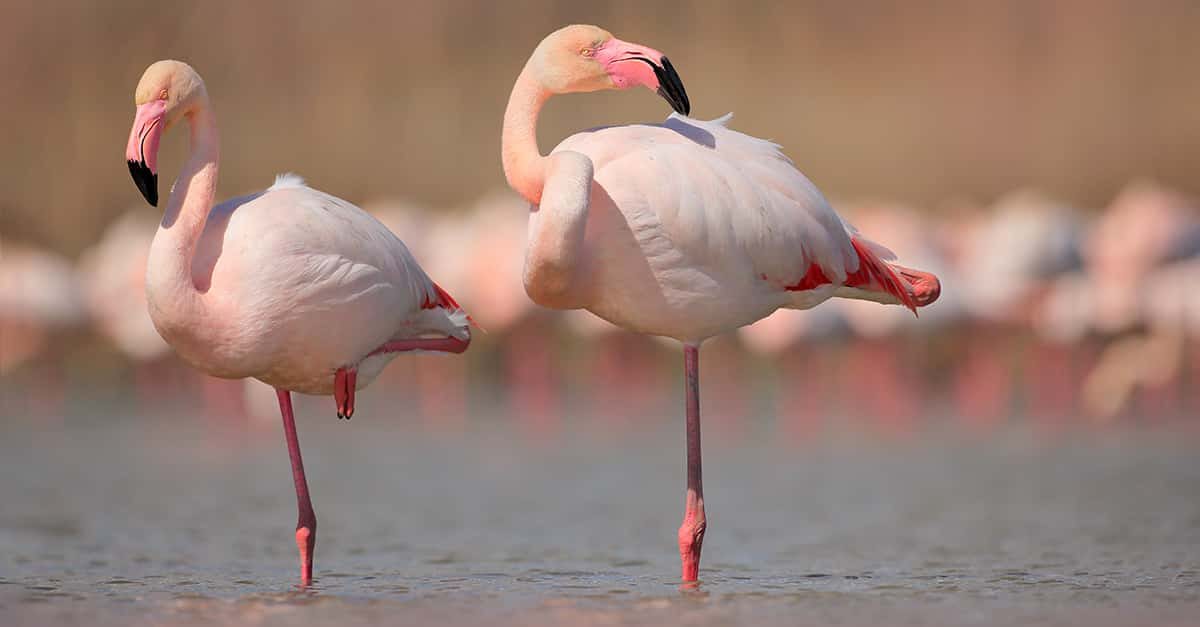There are a lot of bizarre birds in the world. Penguins have left the air for the water. Toucans have comically large beaks. Parrots can talk. Ostriches are…well, just look at them. But, for whatever reason, the flamingo has always captured people’s attention like few other of our feathered friends. And with good reason; flamingos are downright weird. The weird way they stand, their weird beaks, and most of all, their weird color. So why are flamingos pink?
Why Are Flamingos Pink?
They’re technically related to grebes—but they sure don’t look like it. Grebes look pretty similar to any number of waterfowl, but no other bird looks like a flamingo. In fact, the absurd dissimilarity between these close cousins is so stark that scientists have suggested that they should be called the Mirandornithes, Latin for “miraculous birds.”
 Shutterstock Grebe
Shutterstock Grebe
That’s a good word for it. Flamingos do seem rather miraculous—but why? Why do they stand on one leg? Why do they eat upside down? And, most importantly, why are flamingos pink?
Well, the reason that flamingos stand on one leg, with the other one tucked up beneath their body, is honestly something of a mystery. Some scientists believe that it uses less energy. Some believe it helps them maintain their body temperature in cold water. Both seem like good enough theories, but we don’t really know for sure.
Those other two questions though? That we can answer. It all comes back to the old cliche: You are what you eat.
The Pink Diet
Flamingo beaks are unlike anything else in the animal kingdom. Like so many other evolutionary oddities, they serve a very specific purpose. It has to do with the birds’ unique dining strategy. To feed, flamingos dunk those bizarre bills in the water and sweep them from side to side. Thanks to their distinctive shape and thousands of small hairs within, they're able to filter out mud and sediment from the food that they eat.
It's an odd, but effective strategy. And it just so happens that a flamingo's bill, which is perfectly adapted to this task, only works upside down. If you’ve ever tried eating while doing a headstand, you know how difficult it can be, but for flamingos, it beats a knife and fork any day of the week.
So, as flamingos are swinging those beaks through the water, what are they looking for? For the most part, it's two things: brine shrimp and blue-green algae. They may swallow some insects or other small creatures in the course of the day, but those two make up the staples of a flamingo’s diet. They also hold the secret to their iconic color.
The Natural Look is Overrated
Flamingos aren’t born pink. When they hatch, they have a mostly grey plumage. The pink coloration only comes as they grow older—and it’s thanks to a pigment called beta-carotene, a substance that happens to be found in abundance in brine shrimp and blue-green algae.
Now, beta-carotene is fairly common in many foods, but it takes quite a lot of them to have an effect, and a flamingo’s diet definitely qualifies as “high in beta-carotene.” Pretty much everything they eat is bursting with the pigment, and eventually, it has an effect.
The beta-carotene is broken down by enzymes in a flamingo’s digestive system. They’re then absorbed in the liver, then sent out to a flamingo’s feathers, bill, and legs, giving them that distinct pink color that tackily decorates lawns all over the world.

Sign up to our newsletter.
History’s most fascinating stories and darkest secrets, delivered to your inbox daily. Making distraction rewarding since 2017.
Dye Job
So, oddly enough, one answer to the question “Why are flamingos pink?” is “They’re not.” Not without that beta-carotene. If the bird becomes malnourished, its pink color will fade until it’s just plain white. So, you could make the argument that flamingos are technically white, not pink. If a blonde dyes their hair red, does that make them a redhead?
Beta-carotene is also the reason that flamingo color varies from region to region. Areas where the food has the highest beta-carotene content will have the most vibrantly colored flamingos. That’s why the American flamingo of Central America has a brighter red color than the lesser flamingo of Africa.
Flamingos even have a certain level of control over their color. Something called the uropygial gland can make secretions that also contain beta-carotene. During the mating season, flamingos will spread these secretions all over themselves to give them that extra pink-ness and help them impress that special someone.
Our knowledge of how this also works has also helped zoos make sure that their flamingos always stay a nice, picture-perfect pink. People are sure to hand pick a specific diet that’s extremely high in beta-carotene to make sure that captive flamingos have that flamboyant color that we’ve all come to expect.
You Can be a Flamingo Too!
It’s not just flamingos that are affected by beta-carotene, either. As mentioned, all it takes is a diet that’s extremely rich in the pigment for it to have an effect on a creature’s coloration. It can happen to all kinds of animals—including people.
That’s right. If you were to eat a comically large amount of foods containing beta-carotene—take carrots, sweet potatoes, or pumpkins, for example—you’d change color too. You wouldn’t turn pink, mind you. Only flamingos are that lucky. No, if a person eats too much beta-carotene, they’ll just turn a sort of uncanny orange color.
Remember that old episode of Magic School Bus where Arnold turns orange? Or the episode of House where a patient shows the same symptoms? Beta-carotene was the culprit in both of them.
They’ve even made beta-carotene tanning pills that give you that pumpkin orange glow we’re all looking for. Why should flamingos be the only ones to take advantage of this strange phenomena?














